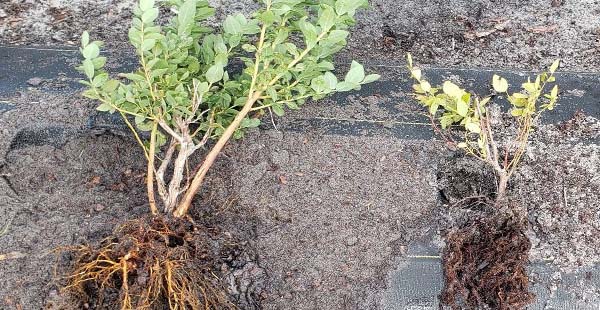Resumen
Roots serve the vital function of water and nutrient uptake for plants. Healthy roots provide the foundation for productive blueberry bushes and require the right horticultural inputs and soil environment to thrive. Less-than-ideal conditions can result in unhealthy, rotten roots, sometimes caused by disease. The most common and destructive root rot disease of southern highbush blueberry (SHB) in Florida is Phytophthora root rot (PRR), caused by the oomycete pathogen Phytophthora cinnamomi Rands. Oomycetes, or “water molds,” favor water-saturated environments. The distinction between oomycetes and fungi is important for disease management, because many fungicides work for only one group, not both. Worldwide, P. cinnamomi is a devastating pathogen of approximately 5,000 woody plant host species. For blueberry growers in Florida, PRR is a persistent problem that is currently managed through careful site selection, preparation, and routine Phytophthora-specific fungicide applications.
Citas
Chandrasekar, S. K. 2008. “Fungicide Resistance in Phytophthora.” Phytophthora workshop, American Phytopathological Society Meeting. MN, USA.
Flor, N. C., D. A. Phillips, and P. F. Harmon. “Botryosphaeria Stem Blight on Southern Highbush Blueberry in Florida: PP347, 4/2019.” EDIS 2019 (2). https://doi.org/10.32473/edis-pp347-2019
Hardham, A. R., and L. M. Blackman. 2018. Phytophthora cinnamomi. Molecular Plant Pathology 19 (2): 260–285. https://doi.org/10.1111/mpp.12568
Harmon, P. F., O. E. Liburd, P. Dittmar, J. G. Williamson, and D. A. Phillips. 2021. “2022 Florida Blueberry Integrated Pest Management Guide: HS1156/HS380, rev. 11/2021.” EDIS 2021 (6). https://doi.org/10.32473/edis-hs380-2021
Ivors, K. L., and G. W. Moorman. 2014. “Oomycete Plant Pathogens in Irrigation Water.” In Biology, Detection, and Management of Plant Pathogens in Irrigation Water, edited by C. Hong, G. W. Moorman, W. Wohanka, and C. Büttner. St. Paul, Minnesota, USA: American Phytopathological Society.
Polashock, J. J., F. L. Caruso, A. L. Averill, and A. C. Schilder. 2017. Compendium of Blueberry, Cranberry and Lingonberry Diseases and Pests. Second Edition. St. Paul, Minnesota, USA: American Phytopathological Society. https://doi.org/10.1094/9780890545386
Smith, B. J. 2002. “Susceptibility of Southern Highbush Blueberry Cultivars to Phytophthora Root Rot.” Acta Horticulturae 574: 75–79. https://doi.org/10.17660/ActaHortic.2002.574.8

Esta obra está bajo una licencia internacional Creative Commons Atribución-NoComercial-SinDerivadas 4.0.
Derechos de autor 2024 UF/IFAS

